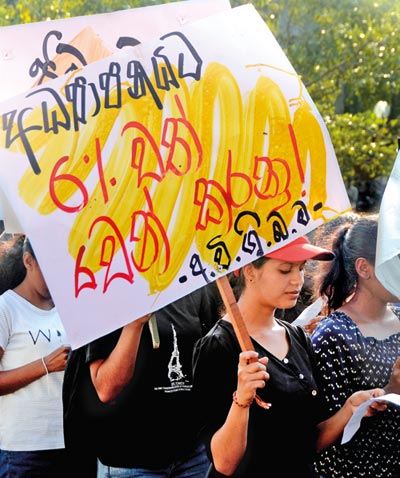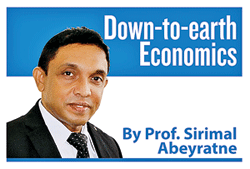Let’s learn some economics!
View(s):
Pic by Priyankara Samaraweera
Let me ask you a question: If the government must allocate 6 per cent of GDP for education, how much is left for all other expenses? After seeing this 6 per cent slogan popping up again and again, I could not resist asking that question.
If your answer is 94 per cent, then you need to learn some economics, because it is wrong! Even if you give the right answer arguing that “it is so in some other countries, so why not in Sri Lanka”, I would say that we still need to learn some economics. If your answer is “I don’t know”, obviously we must know some economics.
The kind of economics that we need to know can be presented in a few numbers related to public finance. Public finance is about taxation and spending, which should be based on accepted norms and principles as well as theories, which are not the areas of our focus here.
Non-education expenditure
Sri Lanka is a 77 billion-dollar economy in terms of the US dollar value of the country’s GDP in 2022; it is such a small economy, compared with 400-500 billion-dollar economies in our neighbourhood such as Thailand, Singapore, Malaysia and Vietnam. I quoted these four countries to give an indication that the size of the economy depends on economic progress, and not necessarily the size of the population or the land extent.
Out of the total GDP of $77 billion, which is equal to 24 trillion rupees, the government has acquired 8.2 per cent in terms of taxes and non-tax revenue in 2022. If the government had allocated 6 per cent of GDP for education, the Treasury would have been left with the balance 2.2 per cent for all other expenditure of the government!
As we remember, there has been significant, but controversial tax hikes since January 2023 in order to raise government revenue and to cut down borrowing requirement. Far-reaching tax reforms applied to income taxes, corporate taxes and indirect taxes such as VAT, excise duties and import duties.
With all forms of tax hikes, the government was able to raise its revenue just by 1.9 percentage points to 10.1 per cent of GDP in 2023. In this case, if 6 per cent of GDP is allocated for education, a 4.1 per cent of GDP is left for all other expenditure of the government.
Other expenditure
Let’s consider these other expenditure items of the government. The government must pay its revenue to meet recurrent and capital expenditure. Out of these two types, recurrent expenditure includes public sector salaries, pensions, subsidies, and interest payments for previous borrowings.
While capital expenditure includes public investment projects, we must not forget that the government should also allocate for repaying the capital component of previous borrowings.
 Apparently, allocation for education is already included in the above. Approximately about 90 per cent of education expenses are for salaries and other recurrent expenses, while its capital component is just about 10 per cent only.
Apparently, allocation for education is already included in the above. Approximately about 90 per cent of education expenses are for salaries and other recurrent expenses, while its capital component is just about 10 per cent only.
As of 2022, the government has spent Rs. 367 billion for education; this is merely 1.5 per cent of GDP which we like to raise to 6 per cent of GDP. If we go by 2022 data, this would have left just 2.2 per cent of GDP for the salaries of the public sector other than education, payment of pensions, subsidies, and all other recurrent expenses.
In fact, even after allocating just 1.5 per cent of GDP for education, the total recurrent expenditure, which remains around 15 per cent of GDP must be managed with two sources: further taxes or further borrowings. Therefore, even after raising taxes so much since 2022, the Budget 2024 has come up with an increase in its borrowing limits.
Misleading stories
Sri Lanka has the lowest expenditure on education among the Asian countries, which is merely 1.2 per cent of GDP, as per the World Bank data. I have no argument against the need for increasing government expenditure on education, as well as on health care and many other areas.
At the same time, there are countries – mostly in the developed world – which has education expenditure at around 6 per cent of GDP. They include some of the Western European and Scandinavian countries such as Denmark, Finland, Iceland, Norway, Switzerland and Sweden as well as UK and US. Here is the point: In most of these countries, the government’s tax revenue also remains as high as 20-40 per cent of GDP.
In Sri Lanka, tax revenue of the government remains less than 10 per cent of GDP. Even with recent tax hikes it is expected to rise little over 12 per cent of GDP in 2024. It is impossible to allocate half of that merely on education!
Secondly, in some countries it is not only the government, but also the people who directly pay for education because it comes at a cost. As a result, the government not only spent on education, but also generates incomes from education. Accordingly, gross comparisons are highly misleading.
In Sri Lanka, private spending on education exists in terms of parents’ contribution to schools, paying for supplementary tuition education, and fee-levying schools. Therefore, if we take mere government expenditure on education, it’s misleading too.
There is considerable private spending on children’s education in Sri Lanka, which is mainly an outcome of “policy failure” of the country. As per Household Income and Expenditure Survey (2019), an average household spends 3.8 per cent of monthly income on education too.
One and only country
We acknowledge the fact that
Sri Lanka has derived positive results from its early effort in policy-making to provide “free education” to all. Nevertheless, Sri Lanka has a policy failure for not being able to capitalise on the early initiatives in education to build a better economy and a society.
The term “free education” doesn’t mean at all that it is a “free commodity” in economic sense. When a commodity requires “resources” to produce and supply it, and when such resources have some other uses, then it is not a “free commodity”. Giving away free doesn’t mean it is free. Thus free education is not at all free.
It is, however, widely accepted that the social benefits of “free education” exceed its costs so that, in general, there is an economic rationale for free education. However, in this case too, there is a distinction between general education at primary and secondary levels and tertiary level education at university and vocational levels.
Even though social benefits are greater at primary and secondary education, private benefits are greater social benefits at tertiary level education. For this reason, all around the world, usually the university education is not free although its access to everyone is ensured through various mechanisms.
The worst case is that even after receiving free education at higher levels using public money, due to its greater private benefits, people have access to better opportunities in foreign countries. Perhaps, Sri Lanka may be the only country in the world that spends public funds from taxes and borrowings to educate its citizens to support development in other countries!
Is spending enough?
Well, the last question demands a bigger analysis. I don’t dispute about the dire need for increasing government expenditure on education in Sri Lanka. But I do dispute about its possible outcome. With an increase in employment, salaries and wages, office maintenance, vehicle maintenance and other subsidies, the recurrent expenditure may rise. With the construction of new buildings and the purchase of new vehicles, capital expenditure may rise too.
It may have a little impact on the qualitative improvement in the country’s education system in general. Sri Lanka has an overdue reform agenda in the education sector, covering all levels of education as well as education administration. Mere increase in pumping public funds will have hardly any impact on the quality and equity of education to all.
The writer is Emeritus Professor of Economics at the University of Colombo and can be reached at sirimal@econ.cmb.ac.lk and follow on Twitter @SirimalAshoka).
Hitad.lk has you covered with quality used or brand new cars for sale that are budget friendly yet reliable! Now is the time to sell your old ride for something more attractive to today's modern automotive market demands. Browse through our selection of affordable options now on Hitad.lk before deciding on what will work best for you!


